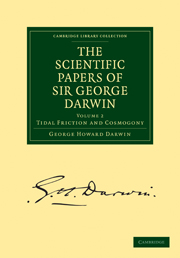Book contents
- Frontmatter
- PREFACE
- Contents
- Chronological List of Papers with References to the Volumes in which they are or probably will be contained
- Erratum in Vol. I
- TIDAL FRICTION AND COSMOGONY
- 1 On the Bodily Tides of Viscous and Semi-elastic Spheroids, and on the Ocean Tides upon a Yielding Nucleus
- 2 Note on Thomson's Theory of the Tides of an Elastic Sphere
- 3 On the Precession of a Viscous Spheroid, and on the Remote History of the Earth
- 4 Problems connected with the Tides of a Viscous Spheroid
- 5 The Determination of the Secular Effects of Tidal Friction by a Graphical Method
- 6 On the Secular Changes in the Elements of the Orbit of a Satellite revolving about a Tidally Distorted Planet
- 7 On the Analytical Expressions which give the History of a Fluid Planet of Small Viscosity, attended by a Single Satellite
- 8 On the Tidal Friction of a Planet attended by Several Satellites, and on the Evolution of the Solar System
- 9 On the Stresses caused in the Interior of the Earth by the Weight of Continents and Mountains
- INDEX
3 - On the Precession of a Viscous Spheroid, and on the Remote History of the Earth
Published online by Cambridge University Press: 07 September 2010
- Frontmatter
- PREFACE
- Contents
- Chronological List of Papers with References to the Volumes in which they are or probably will be contained
- Erratum in Vol. I
- TIDAL FRICTION AND COSMOGONY
- 1 On the Bodily Tides of Viscous and Semi-elastic Spheroids, and on the Ocean Tides upon a Yielding Nucleus
- 2 Note on Thomson's Theory of the Tides of an Elastic Sphere
- 3 On the Precession of a Viscous Spheroid, and on the Remote History of the Earth
- 4 Problems connected with the Tides of a Viscous Spheroid
- 5 The Determination of the Secular Effects of Tidal Friction by a Graphical Method
- 6 On the Secular Changes in the Elements of the Orbit of a Satellite revolving about a Tidally Distorted Planet
- 7 On the Analytical Expressions which give the History of a Fluid Planet of Small Viscosity, attended by a Single Satellite
- 8 On the Tidal Friction of a Planet attended by Several Satellites, and on the Evolution of the Solar System
- 9 On the Stresses caused in the Interior of the Earth by the Weight of Continents and Mountains
- INDEX
Summary
The following paper contains the investigation of the mass-motion of viscous and imperfectly elastic spheroids, as modified by a relative motion of their parts, produced in them by the attraction of external disturbing bodies; it must be regarded as the continuation of my previous paper, where the theory of the bodily tides of such spheroids was given.
The problem is one of theoretical dynamics, but the subject is so large and complex, that I thought it best, in the first instance, to guide the direction of the speculation by considerations of applicability to the case of the earth, as disturbed by the sun and moon.
In order to avoid an incessant use of the conditional mood, I speak simply of the earth, sun, and moon; the first being taken as the type of the rotating body, and the two latter as types of the disturbing or tide-raising bodies. This course will be justified, if these ideas should lead (as I believe they will) to important conclusions with respect to the history of the evolution of the solar system. This plan was the more necessary, because it seemed to me impossible to attain a full comprehension of the physical meaning of the long and complex formulæ which occur, without having recourse to numerical values; moreover, the differential equations to be integrated were so complex, that a laborious treatment, partly by analysis and partly by numerical quadratures, was the only method that I was able to devise.
- Type
- Chapter
- Information
- The Scientific Papers of Sir George DarwinTidal Friction and Cosmogony, pp. 36 - 139Publisher: Cambridge University PressPrint publication year: 2009First published in: 1908



